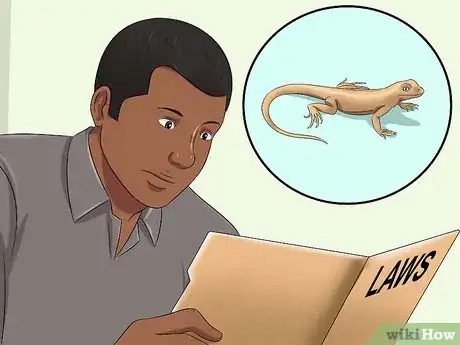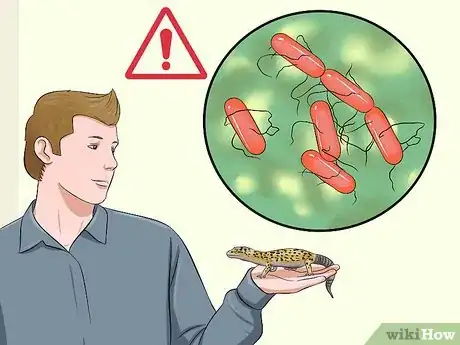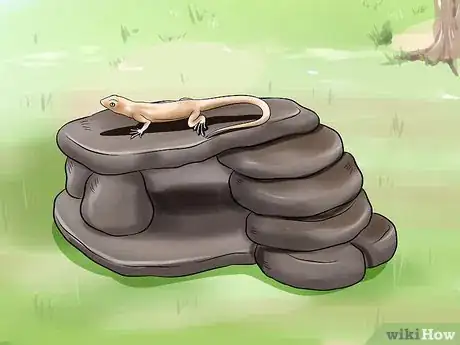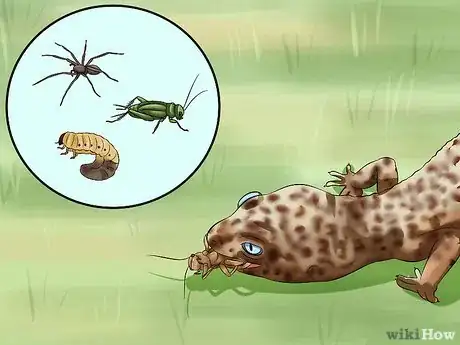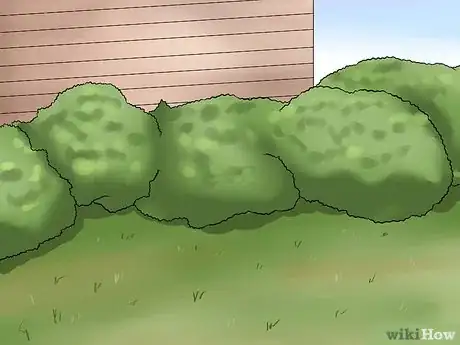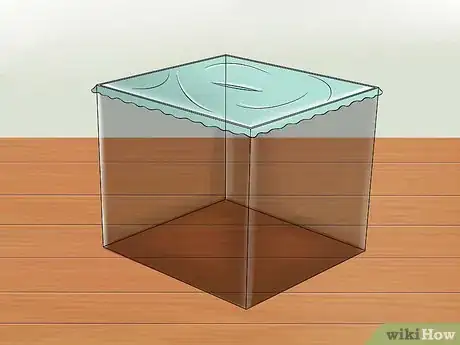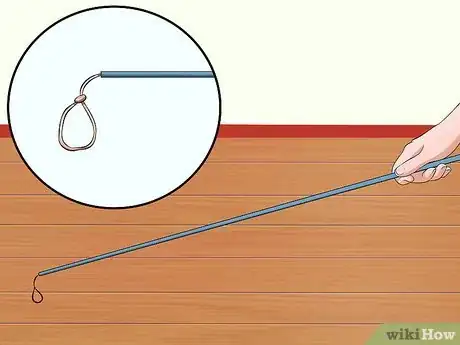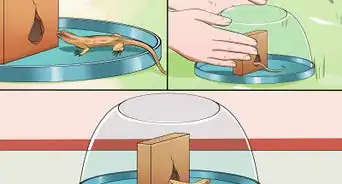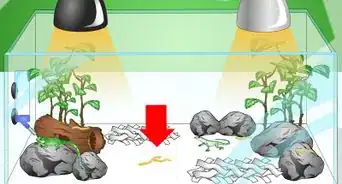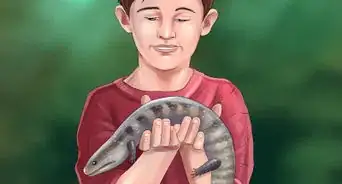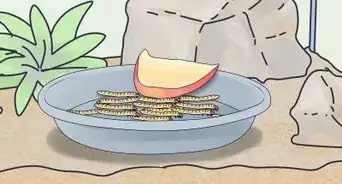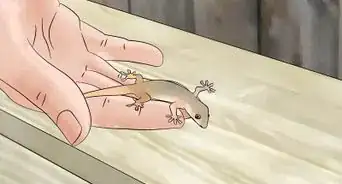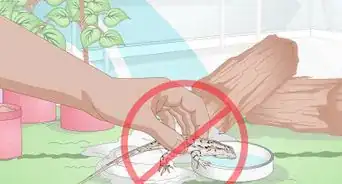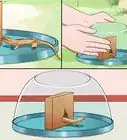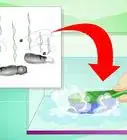This article was co-authored by Pippa Elliott, MRCVS. Dr. Elliott, BVMS, MRCVS is a veterinarian with over 30 years of experience in veterinary surgery and companion animal practice. She graduated from the University of Glasgow in 1987 with a degree in veterinary medicine and surgery. She has worked at the same animal clinic in her hometown for over 20 years.
wikiHow marks an article as reader-approved once it receives enough positive feedback. In this case, 86% of readers who voted found the article helpful, earning it our reader-approved status.
This article has been viewed 36,727 times.
Lizards are found almost anywhere in the world![1] If you have noticed some lizards near your home, you may have wanted to catch one. Always be careful handling wild animals. Handling wild animals can hurt you and the animal. If you want to catch a wild lizard and hold it, there are a few things you can try.
Steps
Researching Lizards Before You Start
-
1Research what lizards live in your area. Review maps that show the habitat of local lizards.[2] This will help give you an idea of what kind of lizards you may be able to catch.
-
2Know which lizards are poisonous or venomous. Before you go out and handle a lizard, make sure you know which ones could be hazard to your health.[3]
- Some lizards, such as bearded dragons and leopard geckos are not only safe to handle but are also the recommended breed of lizard to keep as pets.[4]
Advertisement -
3Research local laws. In the United States, there are laws restricting the ownership and possession of lizards. Make sure you research your local, state, and national laws before bringing home a lizard as a pet.
- Your national government should have information about lizard possession on their website.
-
4Stay healthy. Handling lizards can sometimes cause diseases. Be careful when handling any wild animal, especially lizards, to avoid getting sick with illnesses like salmonella.[5]
- Salmonella can be harmful for small children. If you have kids in your home, consider their safety when bringing home or catching a lizard for a pet.
Attracting Lizards
-
1Set up shelter on your property. Lizards like to have spaces to hide. They also need places to live, to sleep, and to relax. You can attract lizards to your yard if you place natural or man-made structures in your yard.
- Place rocks in your yard for shade and shelter.
- Plant shrubs or leafy vegetation.
-
2Feed local lizards. To lure lizards to your property, you should attract what they eat. If you have an organic and an “untidy” yard or garden, you can attract bugs and moths. The more food you entice, the happier local lizards may be.[6]
-
3Grow specific plants to attract wildlife. Plant shrubs, grasses, and trees to create a more organic yard. Making your backyard a wild habitat will attract wild lizards and keep them happy.
Catching Lizards
-
1Make a glass lizard trap. An easy way to catch a wild lizard is to use a glass lizard trap. You can do this in a few easy steps:
- Clean and prepare a glass box. You want a box large enough to catch the native lizards in your area.
- Cover the top of the box with plastic wrap. You want the lizard to be able to walk on the top of the box.
- Slice a small slit in the top of the plastic wrap. Lizards like to crawl into holes and if a lizard is well fed, it will be more likely to look for a place to rest.
- Locate a lizard habitat. Place the box in your backyard if you’ve noticed a lot of lizards in the area. The more lizards in the area, the better the placement for the trap.
- Put insects or other lizard food on top of the top, near the slit in the plastic wrap. This will entice the lizard to check out the trap.
- Check your trap frequently. Make sure you do not leave a trapped lizard enclosed too long without food and water.
-
2Make a lizard fishing pole. This is also known as using a lizard “noose."
- Use a long stick. You want the stick long enough to serve as a handle.
- Attach a piece of string or waxed dental floss to the end to the stick. This is will help to not scare the lizard when you try to catch it.
- Tie the end of the string into a slip knot. This knot will be able capture the lizard safely without hurting it.
- Slip the noose around the lizard’s head and pull. This will tighten the knot and capture the lizard.
- Gently remove the noose from the lizard’s head. Grasp the lizard in your hand and remove the nose from around the head. Be very careful if the lizard has sharp teeth!
-
3Catch a lizard by hand. If you know if you have safe lizards in the wild, you may be able to catch them by hand.
- Know that lizards move very quickly! This is especially true in long grass. Take some time to observe the habits of lizards before you try and catch it.
- Try and entice lizards closer to your hand by placing lizard food (insects) by your hand.
Expert Q&A
-
QuestionWhat do lizards need to survive in a tank?
 Melissa Nelson, DVM, PhDDr. Nelson is a Veterinarian who specializes in Companion and Large Animal Medicine in Minnesota, where she has over 18 years of experience as a veterinarian in a rural clinic. She received her Doctor of Veterinary Medicine from the University of Minnesota in 1998.
Melissa Nelson, DVM, PhDDr. Nelson is a Veterinarian who specializes in Companion and Large Animal Medicine in Minnesota, where she has over 18 years of experience as a veterinarian in a rural clinic. She received her Doctor of Veterinary Medicine from the University of Minnesota in 1998.
Veterinarian Reptile keeping is very dependent on husbandry (tank environment) and it really depends on each species. It is best to do a lot of research and talk to people who keep lizards to find out the what it needs to survive and thrive in a tank.
Reptile keeping is very dependent on husbandry (tank environment) and it really depends on each species. It is best to do a lot of research and talk to people who keep lizards to find out the what it needs to survive and thrive in a tank. -
QuestionWhat do Arizona lizards like to eat?
 Melissa Nelson, DVM, PhDDr. Nelson is a Veterinarian who specializes in Companion and Large Animal Medicine in Minnesota, where she has over 18 years of experience as a veterinarian in a rural clinic. She received her Doctor of Veterinary Medicine from the University of Minnesota in 1998.
Melissa Nelson, DVM, PhDDr. Nelson is a Veterinarian who specializes in Companion and Large Animal Medicine in Minnesota, where she has over 18 years of experience as a veterinarian in a rural clinic. She received her Doctor of Veterinary Medicine from the University of Minnesota in 1998.
Veterinarian This depends on the lizard. Some are carnivores; others are herbivores; and some are omnivores.
This depends on the lizard. Some are carnivores; others are herbivores; and some are omnivores.
References
- ↑ http://www.lakesidenaturecenter.org/AOM%20-%20Lizards.pdf
- ↑ http://www.eduscapes.com/nature/lizard/index3.htm
- ↑ http://www.britannica.com/list/7-of-the-worlds-most-dangerous-lizards-and-turtles
- ↑ http://www.reptilesmagazine.com/Reptile-Care-For-Beginners/Best-Pet-Reptiles-For-Children/
- ↑ http://www.cdc.gov/features/salmonellafrogturtle/
- ↑ http://www.whatdolizardseat.info/
About This Article
To catch a wild lizard, try using a glass box as a trap. Once you’ve found a box, cover the top with plastic wrap so the lizard can walk on top. Then, cut a slit it in the top, since lizards like to crawl inside holes to look for food. After you’ve cut a slit in the top, leave a few insects or other lizard food next to the slit. Once you’ve left the box near a lizard habitat, come back regularly to check if you've trapped anything. Alternatively, if you spot a lizard you’re sure isn’t poisonous, try enticing it into your hand with insects. For more tips from our Veterinary co-author, including how to catch a wild lizard with a fishing pole, read on!


